废锂离子电池回收的放电和浸出比较研究
IF 4.9
2区 工程技术
Q1 ENGINEERING, CHEMICAL
引用次数: 0
摘要
锂离子电池(LIB)的加速生产意味着原材料需求的增加,尤其是对锂、钴和镍等金属的需求。废旧锂离子电池的回收可确保宝贵材料的再生和重新融入制造业;因此,必须优化回收方法和技术。本研究对碱性和还原性酸浸出工艺进行了评估和比较,以确定 pH 值、温度和试剂浓度等参数对实现选择性浸出工艺的影响。研究表明,强碱性溶液(NaOH)并不能确保锂和铝的选择性溶解。此外,在 pH ∼ 14 时会形成固体化合物 LiAl2(OH)6OH(s),对提锂产生负面影响。另一方面,使用酸性硫酸和硫酸肼(H2SO4 + N2H6SO4)溶液进行还原性酸浸出,可形成一个高效的系统,在 40 °C 时提取出≥90% 的镍、钴和锰。肼作为还原剂是必不可少的,但必须加入过量(相对于钴、镍和锰的含量,过量为 40%)以抑制铜的溶解。此外,这项工作还证明了在卸料和粉碎阶段结束后对整个废 LIBs 样品进行处理的可能性,从而避免了物理分离,同时不影响浸出效率并有助于提高工艺经济性。本文章由计算机程序翻译,如有差异,请以英文原文为准。

A comparative study of discharging and leaching of spent lithium-ion battery recycling
Accelerated production of lithium-ion batteries (LIBs) implies an increase in the raw materials demand, especially for metals like lithium, cobalt, and nickel. Spent LIBs recycling guarantees the regeneration and reincorporation of valuable materials into the manufacturing industry; therefore, recycling methods and techniques must be optimized. In this investigation, alkaline and reductive acid leaching processes were evaluated and compared in order to determine the effect of parameters such as pH, temperature, and reagents concentrations to achieve selective leaching processes. This study demonstrated that strongly alkaline solutions (NaOH) do not ensure selective lithium and aluminum dissolution. Also, a solid compound, can be formed at pH ∼14, negatively affecting the lithium extraction. On the other hand, reductive acid leaching, with acid sulfuric and hydrazine sulfate (H2SO4 + N2H6SO4) solutions resulted in an efficient system, extracting ≥90 % of Ni, Co, and Mn at 40 °C. Hydrazine is essential as a reductant, although it must be added in excess (40 % excess with respect to the Co, Ni, and Mn content) to suppress copper dissolution. Furthermore, this work demonstrated the possibility of processing the entire spent LIBs sample once the discharge and crushing stages were concluded, avoiding physical separation, without affecting the leaching efficiency and contributing to process economy.
求助全文
通过发布文献求助,成功后即可免费获取论文全文。
去求助
来源期刊

Minerals Engineering
工程技术-工程:化工
CiteScore
8.70
自引率
18.80%
发文量
519
审稿时长
81 days
期刊介绍:
The purpose of the journal is to provide for the rapid publication of topical papers featuring the latest developments in the allied fields of mineral processing and extractive metallurgy. Its wide ranging coverage of research and practical (operating) topics includes physical separation methods, such as comminution, flotation concentration and dewatering, chemical methods such as bio-, hydro-, and electro-metallurgy, analytical techniques, process control, simulation and instrumentation, and mineralogical aspects of processing. Environmental issues, particularly those pertaining to sustainable development, will also be strongly covered.
 求助内容:
求助内容: 应助结果提醒方式:
应助结果提醒方式:


